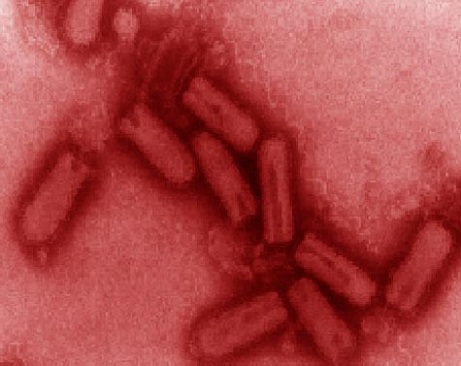Chandipura Vesiculovirus outbreak emerges in Gujerat-India, killing 4, hospitalizing 2. More cases expected
Nikhil Prasad Fact checked by:Thailand Medical News Team Jul 14, 2024 8 months, 4 weeks, 2 days, 6 hours, 7 minutes ago
Medical-News: In a grim development, Gujarat's Sabarkantha district in India is grappling with a deadly outbreak of the Chandipura virus, which has claimed the lives of four children and left two others hospitalized. The virus, notorious for causing severe fever and encephalitis, has sparked concerns among health officials and the local community. The affected children are receiving intensive care at Himmatnagar Civil Hospital, and blood samples have been sent to the National Institute of Virology (NIV) in Pune for confirmation.
 Chandipura Vesiculovirus outbreak emerges in Gujerat-India, killing 4, hospitalizing 2.
Chandipura Vesiculovirus outbreak emerges in Gujerat-India, killing 4, hospitalizing 2.
More cases expected
According to a latest
Medical News release by state health officials, there could be more cases that is yet to have been tested and it is being suspected that sandflies and mosquitoes are the likely vectors for the current outbreak,
The Unseen Enemy: Chandipura Virus
Chandipura virus, a member of the Rhabdoviridae family, is transmitted through vectors such as mosquitoes, ticks, and sandflies. It causes flu-like symptoms and can lead to acute encephalitis, an inflammation of the brain that can be fatal.
https://pubmed.ncbi.nlm.nih.gov/22721825/
First identified in 1965 in Maharashtra, the virus has been linked to various outbreaks in India, including a significant one in 2003 that resulted in 183 deaths among 329 affected children in Andhra Pradesh and Maharashtra.
A History of Devastation
This virus has a notorious history in India. Apart from the major outbreak in 2003, Gujarat itself witnessed sporadic cases and fatalities in 2004. More recent outbreaks have occurred in different parts of the country, underlining the persistent threat posed by this virus. In 2010, for instance, an outbreak in Gujarat's Kheda, Vadodara, and Panchmahal districts resulted in 17 deaths, primarily among children.
Symptoms and Transmission
The Chandipura virus presents with high fever and flu-like symptoms, which can quickly escalate to severe encephalitis. Transmission occurs via vectors, primarily mosquitoes, ticks, and sandflies. The virus's rapid progression from flu-like symptoms to severe neurological damage underscores the importance of prompt medical attention and vector control.
Current Outbreak: The Immediate Response
Following the recent fatalities, district authorities in Sabarkantha have swung into action to contain the outbreak. Teams have been deployed for preventive measures, including the elimination of sandflies in the affected areas. Chief District Health Officer Raj Sutariya has confirmed that blood samples from the affected children have been sent to NIV Pune, with results expected soon.
Local health officials are also coordinating with authorities in neighboring Rajasthan, as two of the affected children are from there. Preventive measures include dusting to eliminate vect
ors and raising public awareness about the virus and its transmission.
Preventive Measures and Public Awareness
Preventing the spread of the Chandipura virus involves a multi-faceted approach, focusing on vector control, public health education, and early diagnosis and treatment. Experts recommend the following measures to curb transmission:
-Vector Control: Eliminating breeding sites for mosquitoes, ticks, and sandflies is crucial. This includes proper sanitation, use of insecticides, and maintaining clean surroundings.
-Public Awareness: Educating communities about the symptoms of the virus, the importance of seeking medical help early, and ways to protect themselves from vector bites is essential.
-Health and Hygiene: Promoting good nutrition and hygiene practices can help boost immunity and reduce the risk of infection.
-Surveillance: Continuous monitoring and surveillance of suspected cases can help in early detection and containment of the virus.
Chandipura Virus: An Ongoing Challenge
The Chandipura virus continues to pose a significant public health challenge in India. Despite ongoing efforts to control its spread, sporadic outbreaks highlight the need for sustained vigilance and proactive measures. The virus's ability to cause rapid and severe illness, particularly among children, makes it a priority for health authorities.
Looking Ahead: A Call for Action
As Gujarat deals with the latest outbreak, it serves as a stark reminder of the importance of preparedness and rapid response in managing infectious diseases. The current situation underscores the need for:
-Enhanced Research: More research is needed to understand the virus's transmission dynamics and develop effective treatments and vaccines.
-Improved Healthcare Infrastructure: Strengthening healthcare facilities, particularly in rural and underserved areas, can ensure timely and adequate medical care for affected individuals.
-Collaboration: Coordination between state and national health agencies, as well as international bodies, is crucial for sharing knowledge, resources, and strategies to combat the virus.
Conclusion: A Community United
The Chandipura virus outbreak in Gujarat is a tragic event that has brought the community together in a unified response. As health officials work tirelessly to contain the virus and prevent further loss of life, the cooperation of the public is vital. By staying informed, following preventive measures, and supporting each other, the community can overcome this challenge and emerge stronger.
For the latest on the Chandipura Vesiculovirus outbreak in India, keep on logging to Thailand
Medical News.
Read Also:
https://www.thailandmedical.news/news/55-symptomatic-poultry-farmworkers-possibly-infected-with-h5n1-in-colorado-3-already-confirmed-via-lab-testing
https://www.thailandmedical.news/news/dengue-crisis-escalates-in-karnataka-india-7006-cases-and-six-deaths-recorded
